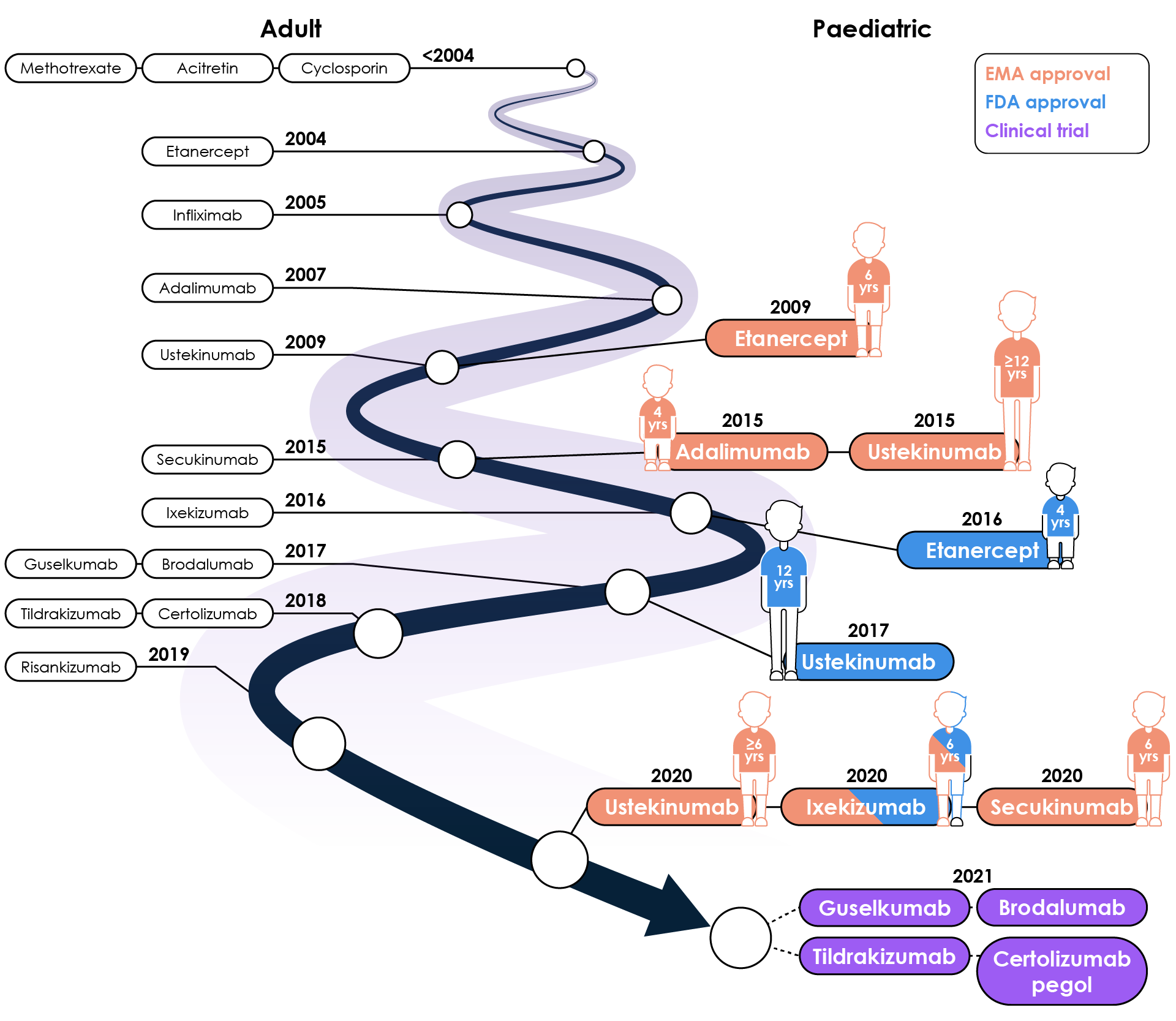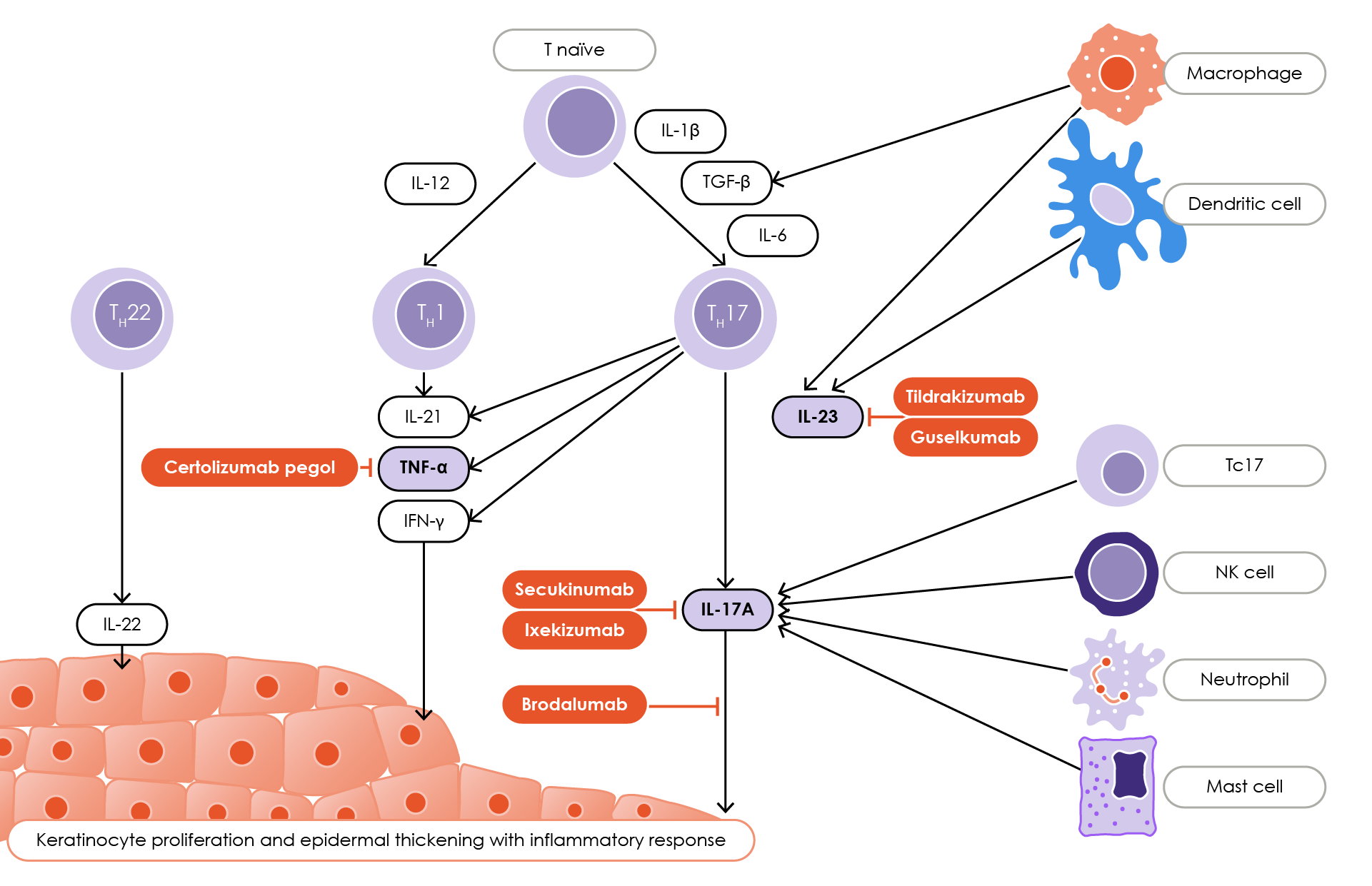
Is the future clear?
- What new treatments for childhood psoriasis might be coming soon?
- See our timeline representing the evolution of psoriasis treatments to ensure you can bring benefit to children in the future
How can we treat Mia next?
With Mia’s psoriasis uncontrolled despite initial treatment with established biologics, her physician discusses newer treatments which could have a positive impact on her quality of life. The European approval of IL-17 inhibitor secukinumab, in addition to ixekizumab, means another targeted therapy for children is now available. Together with her family, Mia and her physician discuss its potential.
Mia’s treatment with an IL-17 inhibitor demonstrates clear benefit, and she and her family believe that with control of her psoriasis, the future is brighter.
Clinical trials for other targeted biologic therapies are underway, offering more options. If trial results continue to demonstrate benefit, effective and safe treatments made available to children like Mia living with psoriasis can provide further improvements to quality of life. Continue on to see how more treatments are evolving.
Is the future clear for Mia and her skin?
As Mia’s need for targeted treatment becomes clear, the evolution of therapeutic options provides hope for the future
The treatment landscape is changing due to recent and ongoing clinical trials offering evidence-based therapeutic options for childhood psoriasis, including those already licensed for use in adults. Secukinumab is one example of a biologic treatment which has recently gained approval in Europe for children following positive results in adults and proven effectiveness in Phase III trials.
As the treatment landscape continues to evolve, you can see the journey through investigation and approval processes that many of the treatments for paediatric psoriasis have taken.

Figure 1. Adapted from ‘What is playing safe in paediatric psoriasis?’ Presented by Professor T. Torres, EADV virtual congress, 30th October 2020.
Additional biologics that target specific cytokines within the inflammatory process that occurs in psoriasis are being studied in clinical trials for their effectiveness in the treatment of children.
Clinical trials are ongoing for more targeted biologic therapies
The IL-17R inhibitor brodalumab (NCT032408091) is in paediatric clinical trials for psoriasis along with the IL-23 inhibitors guselkumab (NCT034518512) and tildrakizumab (NCT039977863), and the TNF-a inhibitor certolizumab pegol (NCT041237954).

Figure 1. Targeted biologics approved or in Phase III clinical trials for use in children with plaque psoriasis (adapted from Lønnberg et al.5).
In terms of non-biologics, the phosphodiesterase 4 (PDE4) inhibitor apremilast is also in a Phase III trial in children aged 6–17 years with moderate-to-severe plaque psoriasis (NCT037017636).
Recent data suggests adult treatments are also effective in children
While limited data from clinical trials has been reported, results appear to be consistent, if not better than, adult data.
Professor Paller gives us her summary of the efficacy and safety in children vs adult data.
Apremilast
Phase II trial data on pharmacokinetics and safety in childhood psoriasis has been published for apremilast7. This first-time-in-children study showed that weight-based apremilast dosing achieved exposure and safety/tolerability similar to that in adults. In addition, this study provided the first evidence of potential efficacy in paediatric patients.
Figure 1. Mean change in PASI score in the safety population who received ≥ 1 dose of apremilast (adapted from Paller et al.8). PASI, Psoriasis area and severity index
Apremilast is also in a Phase III trial in children aged 6–17 years with moderate-to-severe plaque psoriasis (NCT037017636).
Professor Matthias Augustin offers his views on the evolving treatment landscape for paediatric psoriasis.
What changes in the treatment landscape for paediatric psoriasis would help optimise outcomes in this group? Matthias Augustin comments.
Having well-controlled psoriasis in paediatric patients will reduce the impact of psoriasis in later life
There is concern that undertreating children may facilitate the ‘psoriatic march’ from severe untreated inflammation in childhood and its associations to cardiovascular morbidity and mortality in adults9.
Professor Vakirlis describes why early treatment is so important.
In making treatment decisions, it is important for physicians to consider each child’s physical presentation, comorbidities and the effect on QoL, along with the patient’s family. Given that there is no ‘one size fits all’ treatment algorithm9, having as many treatments available to children with psoriasis will offer patients a much greater chance of successful disease control early on with the added bonus of improving long-term health.
Novel paediatric psoriasis targets
Looking even further ahead, we asked Professor Paller about any potential paediatric-specific treatments that could result from current research. Find out what she had to say about IL-2210 and caspase recruitment domain family member 14 (CARD-14) mutations11.
If clinical trial results continue to show promise for the other treatments currently being tested, it is exciting to think that children, like Mia, will also benefit from the wide treatment choice already available to adult patients.
In addition to the availability of targeted treatments for childhood psoriasis, there have been recent positive developments in other aspects of care. Professor Matthias Augustin summarises some of these positive developments.
References
- Clinicaltrials.gov. An open-label, single-dose study to evaluate safety, tolerability, and pharmacokinetics of brodalumab in pediatric subjects. Available at: https://clinicaltrials.gov/ct2/show/NCT03240809. Accessed 5 June 2020.
- Clinicaltrials.gov. A study to evaluate the efficacy, safety, and pharmacokinetics of subcutaneously administered guselkumab for the treatment of chronic plaque psoriasis in pediatric participants. Available at: https://clinicaltrials.gov/ct2/show/NCT03451851. Accessed 9 March 2020.
- Clinicaltrials.gov. A study of tildrakizumab in pediatric subjects with chronic plaque psoriasis. Available at: https://clinicaltrials.gov/ct2/show/NCT03997786. Accessed 14 May 2020.
- Clinicaltrials.gov. A study to evaluate the efficacy, safety, and drug concentration of certolizumab pegol (CZP) in children and adolescent study participants with moderate to severe chronic plaque psoriasis (PSO). Available at: https://clinicaltrials.gov/ct2/show/NCT04123795. Accessed 5 June 2020.
- Lønnberg AS, Zachariae C, Skov L. Targeting of interleukin-17 in the treatment of psoriasis. Clinical, Cosmetic and Investigational Dermatology. 2014;7:251–259.
- Clinicaltrials.gov. Efficacy and safety study of apremilast (CC-10004) in pediatric subjects from 6 through 17 years of age with moderate to severe plaque psoriasis. Available at: https://clinicaltrials.gov/ct2/show/NCT03701763. Accessed 5 June 2020.
- Paller AS, Hong Y, Becker EM, de Lucas R, Paris M, Zhang W, et al. Pharmacokinetics and safety of apremilast in pediatric patients with moderate to severe plaque psoriasis: Results from a phase 2 open-label study. J Am Acad Dermatol. 2020;82(2):389–397.
- Paller AS, Hong Y, Becker EM, de Lucas R, Paris M, Zhang W, et al. Supplementary appendix - Pharmacokinetics and safety of apremilast in pediatric patients with moderate to severe plaque psoriasis: Results from a phase 2 open-label study. J Am Acad Dermatol. doi:10.17632/CM27W42FF3.1.
- Eichenfield LF, Paller AS, Tom WL, Sugarman J, Hebert AA, Friedlander SF, et al. Pediatric psoriasis: Evolving perspectives. Pediatr Dermatol. 2018;35(2):170–181.
- Cordoro KM, Hitraya-Low M, Taravati K, Sandoval PM, Kim E, Sugarman J, et al. Skin-infiltrating, interleukin-22–producing T cells differentiate pediatric psoriasis from adult psoriasis. J Am Acad Dermatol. 2017;77(3):417–424.
- Signa S, Campione E, Rusmini M, Chiesa S, Grossi A, Omenetti A, et al. Whole exome sequencing approach to childhood onset familial erythrodermic psoriasis unravels a novel mutation of CARD14 requiring unusual high doses of ustekinumab. Pediatr Rheumatol. 2019;17(1). doi:10.1186/s12969-019-0336-3.
of interest
are looking at
saved
next event
This content has been developed independently by Medthority who previously received educational funding in order to help provide its healthcare professional members with access to the highest quality medical and scientific information, education and associated relevant content.
